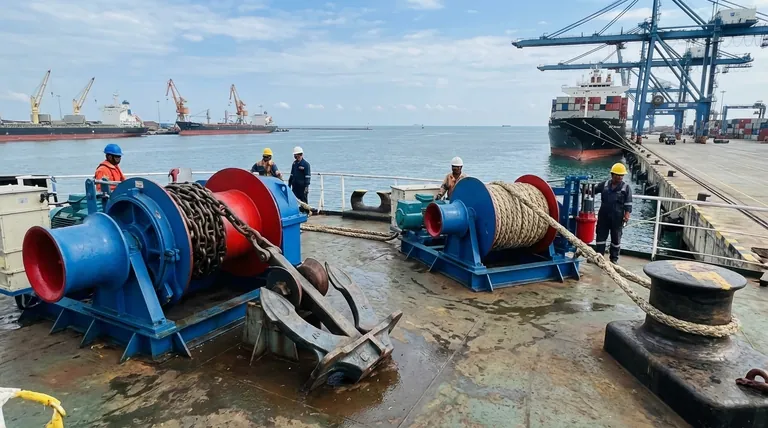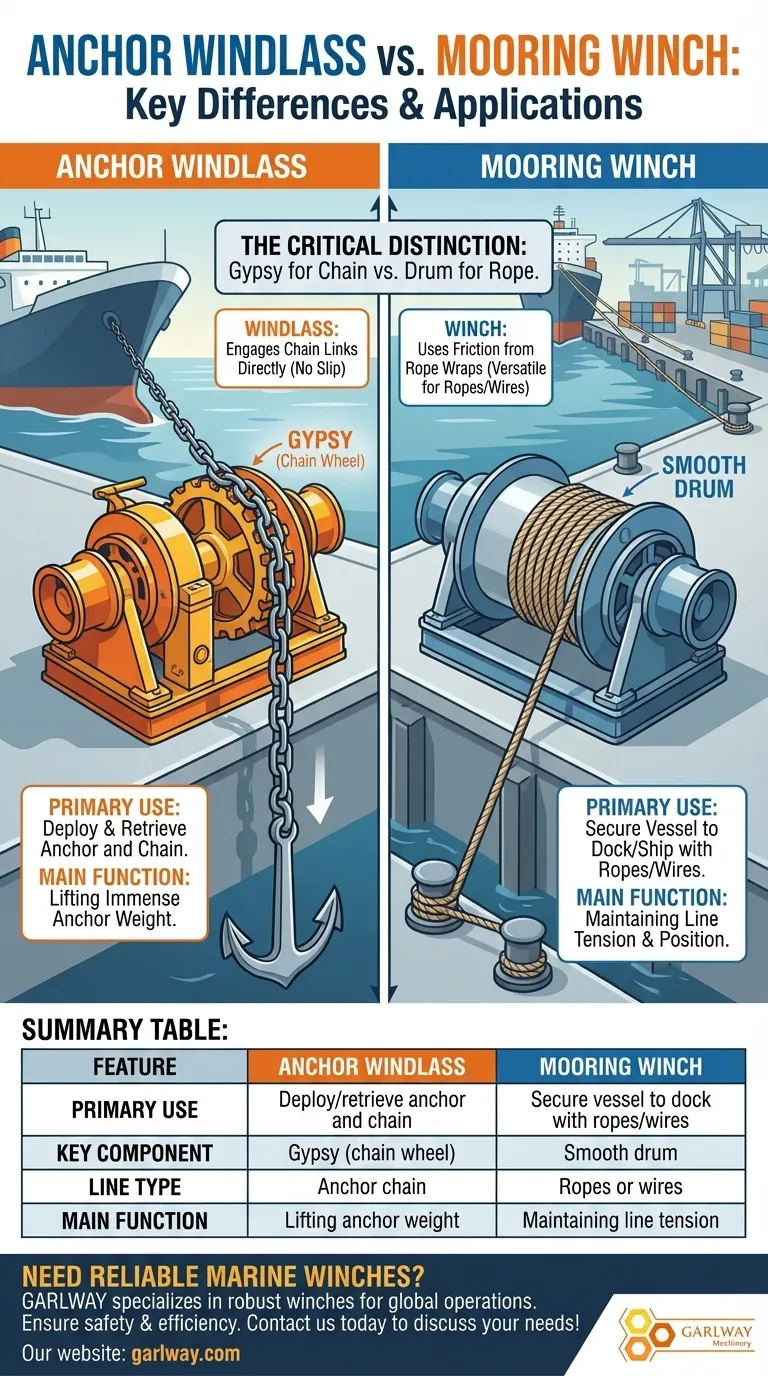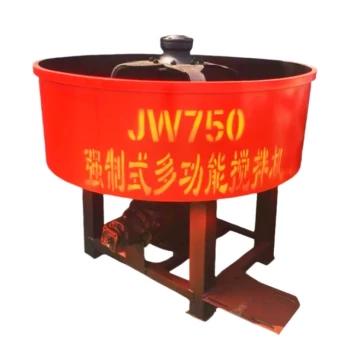In short, an anchor windlass is a specific type of winch designed to deploy and retrieve an anchor using a chain, while a mooring winch is used to handle the ropes or wires that secure a vessel to a dock or another ship. Although both machines pull heavy loads, their design and primary purpose are fundamentally different and are not interchangeable for their core tasks.
The critical distinction lies in the component that engages the line: a windlass uses a notched gypsy specifically designed to grip the links of an anchor chain, whereas a mooring winch uses a smooth drum around which a rope or wire is wrapped.

The Core Functional Distinction: Anchor vs. Mooring
At the heart of this difference are two distinct operational needs on a vessel: holding position at sea versus securing the vessel in port. The equipment is purpose-built for one of these tasks.
The Job of an Anchor Windlass
The primary role of an anchor windlass is to manage the anchor and its rode (the line or chain connecting it to the vessel).
Its main job is to provide the mechanical advantage needed to lift the immense weight of the anchor and chain from the seabed. It also allows for the controlled lowering of the anchor via a brake.
The Job of a Mooring Winch
A mooring winch's function is to manage mooring lines. These lines are used to pull the ship alongside a pier and hold it securely in place against the forces of wind and current.
These winches must handle high-tension ropes or wires, allowing the crew to precisely adjust the ship's position and maintain constant tension.
Anatomy of the Machines: Gypsy vs. Drum
The function of each machine dictates its form. The most telling difference is in the main rotating component that handles the line.
The Windlass Gypsy: A Specialized Tool for Chain
An anchor windlass is defined by its gypsy (also called a chain wheel). This is a notched wheel precision-engineered to engage and grip the individual links of an anchor chain.
This direct link-by-link engagement provides the secure grip necessary to lift a heavy anchor without slippage. The gypsy must be perfectly matched to the chain's size (e.g., a 10mm gypsy for 10mm chain) to function safely.
The Winch Drum: Versatility for Ropes and Wires
A mooring winch uses a large, smooth drum (sometimes called a mooring drum). It works by wrapping a rope or wire around the drum multiple times.
The friction generated by these wraps allows the winch to pull and hold the line. This design is versatile, as it can handle various sizes and types of ropes or wires, but it cannot grip a chain.
The Role of the Capstan (Warping Drum)
To add to the confusion, many anchor windlasses—especially on smaller vessels—include a smooth, vertical drum called a capstan or warping drum.
This component is mounted on the side of the windlass and can be used to handle ropes, essentially allowing the windlass to perform secondary mooring duties. However, the machine's primary identity as a windlass comes from the presence of the gypsy for the anchor chain.
Common Pitfalls and Misconceptions
Understanding the design differences helps avoid dangerous operational mistakes. The two systems are not interchangeable for their primary roles.
Using the Wrong Tool for the Job
You can never use a standard mooring winch drum to retrieve an anchor chain. The smooth drum provides no positive grip on the chain links, which would slip under load, leading to a catastrophic failure.
Likewise, the gypsy on a windlass is useless for a mooring rope. While you can use the attached capstan head, a dedicated mooring winch on a large vessel is built to handle the much higher and more sustained line tensions involved in mooring operations.
Confusing "Winch" as a General Term
"Winch" is a broad term for a device that pulls on a rope or cable. An anchor windlass is a highly specialized type of winch.
Calling a windlass a "winch" is technically correct but imprecise. In a maritime context, it's crucial to use the correct term to identify the equipment's specific function.
Making the Right Choice for Your Task
Your operational goal dictates the necessary equipment. Using the wrong system compromises both efficiency and safety.
- If your primary focus is anchoring: You absolutely require an anchor windlass with a gypsy correctly sized for your specific anchor chain.
- If your primary focus is securing a vessel alongside a pier: You need one or more mooring winches with drums designed to handle the tension and length of your mooring lines.
- If you operate a smaller vessel with combined needs: A combination windlass featuring both a gypsy for the chain and a capstan/warping drum for lines offers a practical, space-saving solution.
Ultimately, recognizing that each machine is a purpose-built tool for a distinct and critical maritime task is the key to safe and effective vessel operations.
Summary Table:
| Feature | Anchor Windlass | Mooring Winch |
|---|---|---|
| Primary Use | Deploy/retrieve anchor and chain | Secure vessel to dock with ropes/wires |
| Key Component | Gypsy (chain wheel) | Smooth drum |
| Line Type | Anchor chain | Ropes or wires |
| Main Function | Lifting anchor weight | Maintaining line tension |
Need reliable marine winches for your vessel? GARLWAY specializes in construction machinery, offering robust winches, concrete mixers, and batching plants for construction companies and contractors globally. Our solutions ensure safety and efficiency in demanding environments. Contact us today to discuss your specific needs and discover how GARLWAY can support your operations!
Visual Guide

Related Products
- Electric Hoist Winch Boat Anchor Windlass for Marine Applications
- Heavy Duty Electric Boat Winch Windlass Anchor
- Warn Winch Windlass Boat Trailer Winch
- Best 18000 Pound Drum Anchor Trailer Winch
- Ready Mixer Machine for Construction Ready Mix Machinery
People Also Ask
- Why won't my electric hoist go up or down? A Step-by-Step Troubleshooting Guide
- How should the hoist winch be debugged after installation? A 3-Phase Guide to Ensure Safety & Reliability
- How do electric hoists provide precise load control? Achieve Safe & Accurate Lifting
- What are the key steps for installing a hoist winch? Ensure Safety & Reliability for Your Project
- How do electric hoists help prevent workplace injuries? Engineer a Safer, More Efficient Workspace



















